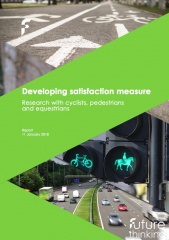Developing satisfaction measure Research with cyclists, pedestrians and equestrians
Document types:
Document weight:
Document geography:
Geographical spread:
Transport Focus represents the interests of users of England’s motorways and major ‘A’ roads (the Strategic Road Network or SRN) and therefore wanted to understand the experiences and needs of cyclists, pedestrians, equestrians and carriage drivers who travel along SRN ‘A’ roads or need to cross any part of the SRN.
Future Thinking was commissioned to study these audiences, exploring not only their attitudes towards and interactions with the SRN but to also gauge views of the best means by which to achieve a robust future measurement of SRN satisfaction for these groups.
This research was wholly qualitative comprising focus groups and in-depth interviews with cyclists, pedestrians and equestrians/carriage drivers across five key locations (included as case studies within this report):
Dover
Manchester
Worthing/Shoreham York
Newcastle
Depth interviews were also conducted with cyclists, pedestrians and equestrians in areas at risk of SRN avoidance or severance:
Hastings Didcot
Lowestoft
Key Findings
People are able to assess the SRN’s functionality from different perspectives, with many overlaps in types of use. In addition to cycling, walking or riding along or across the SRN they are frequently using motorised vehicles on such roads and therefore perceptions can be coloured by varied experiences.
Cyclists, pedestrians and equestrians rarely consciously reflect on how well the SRN specifically meets their needs. If they experience positive aspects they are valued and recognised in comparison to poorer provision. Where negative aspects of the SRN are experienced, a resignation to the situation is evident rather than any expectation of improvement. However, these issues can significantly affect journeys and accessibility and consequently their overall attitudes towards the network.
Across the research, there are consistent experiences which are evident for cyclists, pedestrians and equestrians when coming into contact with the network. These encompass:
Infrastructure – scepticism that the needs of all SRN users are taken into account when designing new or redeveloped parts of the network
General provision – varied provision for cyclists, pedestrians and equestrians across the network with some areas rated highly and others poorly. This leads to doubts that Highways England understands the needs of such audiences
Road user behaviour – appeal for greater education of drivers on safety protocol when driving next to or past cyclists, pedestrians & equestrians
Severance and avoidance – many areas of the SRN are avoided for both travelling along and crossing, due to an absence of safe rights of way as well as the speed and volume of other road users. There can also be issues of severance where an area is dissected by an SRN road without sufficient or safe means of accessing key facilities
The recurring issue for cyclists, pedestrians and equestrians is where there is a necessity to directly access or cross the SRN without a suitable right of way causing concerns for safety.

